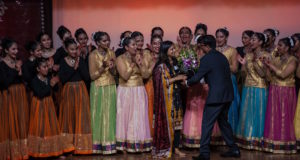”˜Laasya’ : a magical evening of Kathak

Ruchi Sanghi Dance Company presented a two-hour Kathak spectacular ‘Laasya’. Pics Courtesy Dusk Devi Vision.
By Aradhana Bhatt
“The dance can reveal everything mysterious that is hidden in music, and it has the additional merit of being human and palpable. Dancing is poetry with arms and legs”, said Charles Baudelaire, one of the most compelling poets of the 19th century. It is this characteristic of dance as an art form that also makes it a pursuit of self-discovery that leads to Divinity. Sydney is now home to a diverse range of Indian art forms and art lovers of Sydney are regularly treated to high calibre performances by local talents.
Saturday, 6th October was one of those rare evenings when Kathak took centre-stage at Pacific Hills Christian School MPC. Students of Ruchi Sanghi Dance Company presented a two-hour dance spectacular ”˜Laasya’ in front of an appreciative audience. ”˜Laasya’, in Hindu mythology, refers to Goddess Parvati’s dance in response to the male energy of Shiva’s ”˜Tandav’. ”˜Laasya’, thus signifies femininity and grace. Ruchi Sanghi has made a mark in Sydney since the inception of her Kathak school in 2000 and has created a track-record of productions like ”˜Devdas, the Musical’, productions that speak of her creativity and of the disciplined training she imparts.


”˜Laasya’ opened with an upbeat invocation to Ganesha and what followed was a judicious mix of hard-core classical dance items like the ”˜Tarana’, ”˜Jugalbandi’ and ”˜Shuddha Nritta’ interspersed with ”˜Gazal’ and ”˜Mujra’ ”“”˜abhinaya’ based semi-classical dances depicting ”˜Shringar rasa’. The folk forms of dance were not forgotten and the graceful dancers stepped in rhythm to ”˜Garba’, ”˜Ghoomar’, ”˜Chirmi’ and ”˜Kalbeliya’ from Gujarat and Rajasthan. Of course no dance show would be complete without contemporary Bollywood. The finale was a tributary medley of some of the most popular Madhuri Dixit songs from films. The dazzling array of costumes and the spectacular lighting, near seamless back-stage management, combined to render a flawless execution with immaculate choreography of the performances, which involved a total of over fifty dancers ranging from six to forty years in age.







An important aspect of a classical dance performance is the music. Recorded music has become the norm these days, especially in performances overseas, where adequate musical resources are sparse. But a choice of more euphonious musical renditions could have made ”˜Laasya’ more appealing to all of the senses. Solo dancers or dances involving fewer performers would have been not only a welcome visual change, but also would give dancers the space, the freedom and individuality for interpretation of the ”˜Rasa’ in dance items like the ”˜Gazal’ or ”˜Mujra’.
To top this artistic success, the performance was in aid of several charities and the entire proceeds from the night were donated to organisations working to support people with disabilities. ”˜Saaya, touching lives’, the event organisers, have been working tirelessly and selflessly to donate funds to several charities locally and in India, including the striving farmers and orphanages. They met their fundraising target through this event and donated substantial amounts to two Sydney organisations – TAD(Sydney) and The Harman Foundation.
Ruchi Sanghi and her entire team deserve standing ovation along with the organisers ”˜Saaya, touching lives’ for an evening that will continue to reverberate in our memories for a long time to come.
Short URL: https://indiandownunder.com.au/?p=11740
